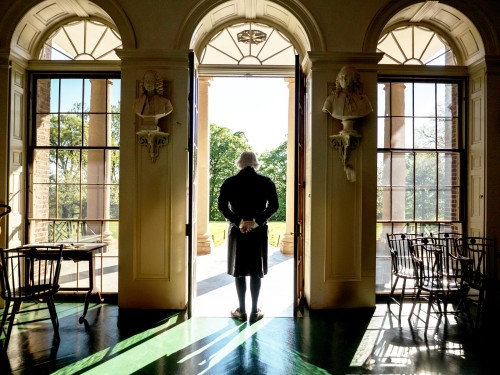It was as President of the United States that Thomas Jefferson had the greatest impact on the Indian nations of North America. He pursued an Indian policy that had two main ends. First, Jefferson wanted to guarantee the security of the United States and so sought to bind Indian nations to the United States through treaties. The aim of these treaties was to acquire land and facilitate trade, but most importantly to keep them allied with the United States and not with European powers, namely England in Canada and Spain in the regions of Florida, the Gulf Coast and lands west of the Mississippi River.
Secondly, Jefferson used the networks created by the treaties to further the program of gradual "civilization." His Federalists predecessors had begun this program, but it was completely in keeping with Jefferson's Enlightenment thinking. Through treaties and commerce, Jefferson hoped to continue to get Native Americans to adopt European agricultural practices, shift to a sedentary way of life, and free up hunting grounds for further white settlement.
The desire for land raised the stakes of the "civilization program." Jefferson told his agents never to coerce Indian nations to sell lands. The lands were theirs as long as they wished, but he hoped to accelerate the process. In a letter to William Henry Harrison, written as the diplomatic crisis leading to the Louisiana Purchase unfolded, Jefferson suggested that if the various Indian nations could be encouraged to purchase goods on credit, they would likely fall into debt, which they could relieve through the sale of lands to the government. The "civilization program" would thus aid the Indians in accordance with Enlightenment principles and at the same time further white interests.
American Indian peoples were divided as to how to respond to Jefferson's policies. The Shawnee chief Black Hoof embraced the "civilization program," and he and many Shawnee settled within the state of Ohio and lived as farmers, while the Shawnee war leader Tecumseh took a different course and led the formation of a pan-Indian resistance movement against the United States government in the years prior to the War of 1812. Some of the Indian nations in the South also accepted the "civilization program" and eventually became known as the "Five Civilized Tribes." Many in the Creek and Cherokee nations built towns and plantations, and some individuals held African American slaves just as their white neighbors. Yet many southern Indians remained skeptical of "civilization" and joined Tecumseh's movement. Among the Creeks, a distinct anti-white resistance movement called the Red Sticks rose against the United States and the Creek nation itself during the War of 1812.
